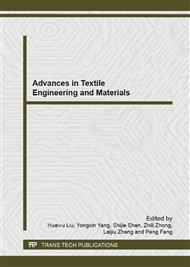[1]
A.J. Moulson, J.M. Herbert, Electroceramics: Materials, Properties, Applications, second ed., John Wiley, Chichester, (2003).
Google Scholar
[2]
R. Guo, L.E. Cross, S.E. Park, B. Noheda, D.E. Cox and G. Shirane, "Origin of the High Piezoelectric Response in PbZr1-xTixO3," Phys. Rev. Lett., 84, 5423(2000).
Google Scholar
[3]
A.K. Singh, D. Pandey, "Evidence for MB and MC phases in the morphotropic phase boundary region of (1-x)[Pb(Mg1/3Nb2/3)O3]-xPbTiO3: A Rietveld study," Phys. Rev. B.,67, 064102(2003).
Google Scholar
[4]
Y. Saito, H. Takao and T Tani, "Lead-free piezoelectric,"Nature, 84, 432(2004).
Google Scholar
[5]
H. L. Du, W. C. Zhou and F. Luo, "High Tm lead-free relaxor ferroelectrics with broad temperature usage range: 0.04BiScO3-0.96(K0.5Na0.5)NbO3," J. Appl. Phys., 104, 044104 (2008).
DOI: 10.1063/1.2969773
Google Scholar
[6]
S. J. Zhang, R. Xia and H. Hao, "Mitigation of thermal and fatigue behavior in K0.5Na0.5NbO3-based lead free piezoceramics,"Appl. Phys. Lett., 92, 152904 (2008).
Google Scholar
[7]
E. Li, R. Suzuki and T. Hoshina, "Dielectric, piezoelectric, and electromechanical phenomena in (K0.5Na0.5)NbO3–LiNbO3–BiFeO3–SrTiO3 ceramics," Appl. Phys. Lett., 94, 132903 (2009)
DOI: 10.1063/1.3112564
Google Scholar
[8]
H. L. Du and F. Luo, "Phase structure, microstructure, and electrical properties of bismuth modified potassium-sodium niobium lead-free ceramics,"J. Appl. Phys., 102, 054102 (2007).
DOI: 10.1063/1.2775997
Google Scholar
[9]
L. Wu, J. L. Zhang, C. L. Wang, and J. C. Li, "Influence of compositional ratio K/Na on physical properties in (KxNa1-x)NbO3 ceramics," J. Appl. Phys. 103, 084116 (2008).
DOI: 10.1063/1.2907866
Google Scholar
[10]
J. G. Wu, D. Q. Xiao and Y. Y. Wang,"Improved temperature stability of CaTiO3-modified [(K0.5Na0.5)0.96Li0.04](Nb0.91Sb0.05Ta0.04)O3 lead-free piezoelectric ceramics," J Appl. Phys., 104, 024102(2008).
DOI: 10.1063/1.2956390
Google Scholar
[11]
Y. F. Chang, Z. P.Yang and D. F. Ma, "Phase transitional behavior, microstructure, and electrical properties in Ta-modified [(K0.458Na0.542)0.96Li0.04]NbO3 lead-free piezoelectric ceramics," J. Appl. Phys., 104, 024109 (2008).
DOI: 10.1063/1.2957591
Google Scholar
[12]
C. Lei and Z. G. Ye, "Lead-free piezoelectric ceramics derived from the K0.5Na0.5NbO3–AgNbO3 solid solution system,"Appl. Phys. Lett., 93, 042901 (2008).
DOI: 10.1063/1.2956410
Google Scholar
[13]
S. J. Zhang, R. Xia and T. R. Shrout, "Lead-free piezoelectric ceramics vs. PZT?," J Electroceramics.,19,251(2007).
DOI: 10.1007/s10832-007-9056-z
Google Scholar
[14]
Y. Dai, X. Zhang and G. Zhou, "Phase transitional behavior in K0.5Na0.5NbO3–– LiTaO3 ceramics," Appl. Phys. Lett., 90, 262903(2007).
Google Scholar
[15]
E. K. Akdogan, K. Kerman and M. Abazari, "Origins of high piezoelectric activity in (K0.44,Na0.52,Li0.04)(Nb0.84,Ta0.10, Sb0.06)O3," Appl. Phys. Lett.,92, 112908(2008).
Google Scholar
[16]
H. M. Zhang, J. B. Zhao, S. B. Qu, Zhuo Xu, "Effect of A-site Non-stoichiometry on polarization degree of K0.5Na0.5NbO3 lead-free piezoelectric ceramics" Journal of Air Force engineering university (nature science edition)., Vol. 13 (2012), p.91,in Chinese.
Google Scholar
[17]
W. Cochran, "Crystal stablity and the theory of ferroelectricity," Adv.Phys., 9, 387(1960).
Google Scholar
[18]
K. Uchino and S. Nomura, "Critical exponents of the dielectric constants in diffused-phase-transition crystals," Ferroelectr. Lett. Sect., 44, 55(1982).
DOI: 10.1080/07315178208201875
Google Scholar
[19]
C. A. Randal, A. S. Bhalla and T. R. Shrout. "Classification and consequences of complex lead perovskite ferroelectrics with regard to B-site cation order," J. Mater. Res., 5, 4(1990).
DOI: 10.1557/jmr.1990.0829
Google Scholar
[20]
Z. G. Ye, "Relaxor Ferroelectric Complex Perovskites: Structure, Properties and Phase Transitions," Key Eng. Mater., 155,81(1998).
DOI: 10.4028/www.scientific.net/kem.155-156.81
Google Scholar


